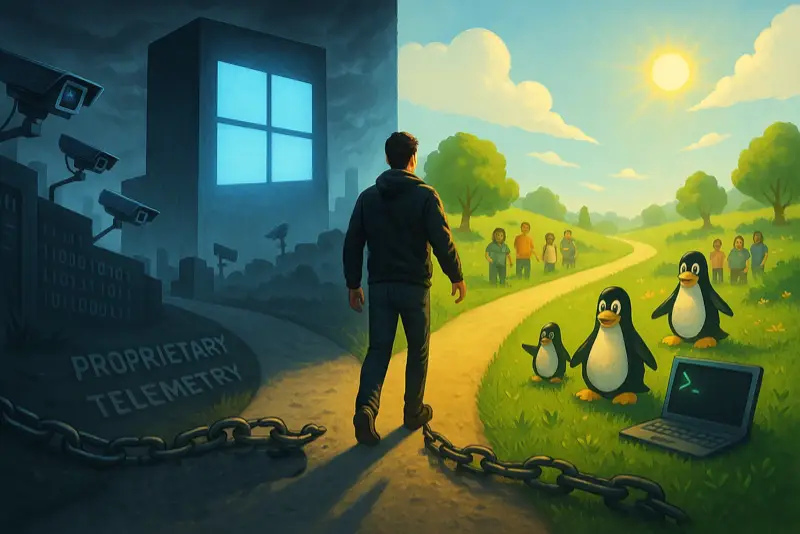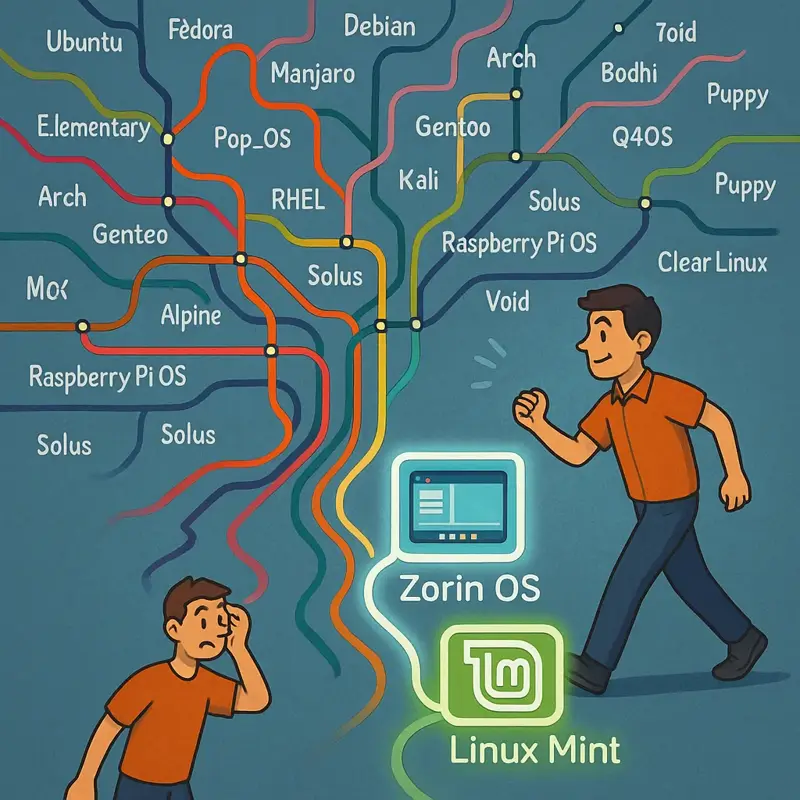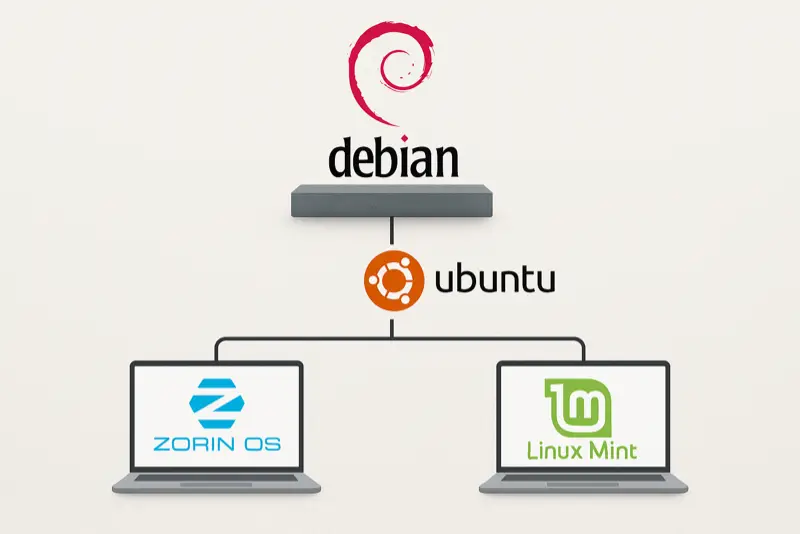Switching from Windows to Linux (1)
By Raymond Girbes -
May 15, 2025
- 6 minutes read

The Transition from Windows to Linux
In this article, I'll take you on my journey to switch from Windows to Linux. Over the upcoming weeks and months, I'll be documenting my experiences through this blog. I've been working on the transition since January 2025, allowing ample time for testing before sharing my findings with you.
Fully transitioning won't happen overnight, as other parties still work with Windows files, which aren't fully compatible. My goal is to use a single computer capable of running Windows software. It doesn't have to be a Windows computer; with a Windows simulator, you can still run Windows programs on Linux.
What's the motivation?
The catalyst was Microsoft's decision to develop a program that takes a screenshot of my screen every few seconds. This could result in Microsoft obtaining all sorts of sensitive information like passwords, secret development codes, addresses, etc. Just imagine having all your customer data open and then there's a screenshot taken.
I certainly don't want that, do you?
The program is called Microsoft Recall.
According to Microsoft, it only stores data locally.
But who believes that when Microsoft increasingly places data on its cloud storage?
Even without consent, requiring you to disable it yourself.
You can disable the program, but what does that mean?
Is it like turning off your location service on your smartphone and it still going on?
Funnily enough, by “disable” they mean you can't use it anymore.
Their interests lie simply in data collection and cloud services.
It's bewildering that no politicians or lawmakers have prohibited Microsoft from implementing such surveillance programs.
Just the thought of a company developing software to spy on users worldwide…
After 30 years in IT, I've seen enough and simply can't trust a company like Microsoft anymore.
Fully transitioning won't happen overnight, as other parties still work with Windows files, which aren't fully compatible. My goal is to use a single computer capable of running Windows software. It doesn't have to be a Windows computer; with a Windows simulator, you can still run Windows programs on Linux.
What's the motivation?
The catalyst was Microsoft's decision to develop a program that takes a screenshot of my screen every few seconds. This could result in Microsoft obtaining all sorts of sensitive information like passwords, secret development codes, addresses, etc. Just imagine having all your customer data open and then there's a screenshot taken.
I certainly don't want that, do you?
The program is called Microsoft Recall.
According to Microsoft, it only stores data locally.
But who believes that when Microsoft increasingly places data on its cloud storage?
Even without consent, requiring you to disable it yourself.
You can disable the program, but what does that mean?
Is it like turning off your location service on your smartphone and it still going on?
Funnily enough, by “disable” they mean you can't use it anymore.
Their interests lie simply in data collection and cloud services.
It's bewildering that no politicians or lawmakers have prohibited Microsoft from implementing such surveillance programs.
Just the thought of a company developing software to spy on users worldwide…
After 30 years in IT, I've seen enough and simply can't trust a company like Microsoft anymore.
Why Choose Linux?
Linux is reliable, cost-effective (starting at zero euros), fast, and doesn't make heavy demands on your hardware.
By 2025, it has also become user-friendly, with most printers being supported.
What are my requirements?
For business purposes, gaming capabilities are not crucial (although you can game on Linux, it's not a requirement).
By 2025, it has also become user-friendly, with most printers being supported.
What are my requirements?
- An interface similar to Windows
- Easy login and logout
- Simple user creation without requiring an account
- Easy update process
- Simple software installation
- Ability to read PDF files
- Ability to import and export Word documents
- Ability to import XLS and CSV files
- Use of a password manager
- Use of different browsers
- Availability of a calculator
- A basic text editor
- Photo editing capabilities
- Good office suite for documents, spreadsheets, and presentations
- Ability to use chat and social media apps like X, Facebook, Instagram, Telegram, Signal, WhatsApp
- File storage on a NAS
- Control of another PC via Remote Desktop
- Easy network setting adjustments
- A Windows simulator for running Windows programs
For business purposes, gaming capabilities are not crucial (although you can game on Linux, it's not a requirement).

Photo illustration: © HRC DIGITAL B.V.
There is a wide selection of Linux distributions. Over the years, I've tested dozens of them, both server and desktop versions. When it comes to desktops, it hasn't always been easy introducing Linux to someone new to it. Thankfully, that's a thing of the past. In my opinion, two distributions stand out for being user-friendly and sharing similarities with Windows.
The two I've ultimately chosen are Linux Mint and Zorin OS. Of course, this is a personal choice but it's based on experience and realistic demands. Zorin OS and Linux Mint are based on Ubuntu, which in turn is based on Debian. In my view, Debian is the most stable Linux distribution available. No developer antics or commercial gimmicks, just a solid and stable system.
The two I've ultimately chosen are Linux Mint and Zorin OS. Of course, this is a personal choice but it's based on experience and realistic demands. Zorin OS and Linux Mint are based on Ubuntu, which in turn is based on Debian. In my view, Debian is the most stable Linux distribution available. No developer antics or commercial gimmicks, just a solid and stable system.
The Winner: Zorin OS
Zorin OS is the operating system I've ultimately chosen. It's free and includes virtually everything you need.
Further Explanation
Points 1 to 4
Simply perfect.
Point 5
The software that can be seamlessly integrated is accessible through the Software Store. There's definitely more software you can install beyond what's available there, but you'll just need a little extra know-how for that! I’ll share more about this in a different blog post.
Point 6
An incredibly fast PDF reader is included by default. You'll be surprised at how quickly PDFs open.
Point 7
With office programs like LibreOffice, you can open Word documents unless they're password-protected. If they are, you can't open them because Microsoft hasn't released the encryption method. You'll need to remove the password in Word first.
Point 8
CSV files can be imported excellently via an office program like LibreOffice. XLS files can also be imported effortlessly unless they're password-protected. See point 7.
Point 13
There are many photo editing programs available. I'll describe the possibilities in more detail in a separate blog. Some examples are GIMP and Photopea. You might also consider purchasing the Pro version of Zorin OS for under 50 euros, which includes an excellent photo editor and more extra software.
Point 14
LibreOffice and OnlyOffice are very good for handling all your documents, presentations, and calculations. Personally, I mostly use LibreOffice, and occasionally OnlyOffice. OnlyOffice looks very nice, but its downside is it doesn't see network drives by default. So, your NAS isn't visible, which isn't ideal. Such things need to work out of the box.
Point 15
All chat programs can be used through a browser. In my view, that's all you need. Telegram and Signal also have native apps. But for those who absolutely need a native app, see point 19.
Point 16
Through Network, you can easily create fixed links to your NAS, which appears as an extra drive. Very simple, yet highly effective.
Point 17
Frankly, it's hard to rival Microsoft with Remote Desktop. Even Apple, in my view, struggles to provide the same experience. A Remote Desktop program that works well within your own network is sufficient. For this, I use Thincast Remote Desktop, downloadable via Zorin OS. If you want to control another computer via the internet, RustDesk is a good option. You can also control other computers remotely through a so-called Zero Trust Network like Tailscale. However, this goes beyond just installing and clicking a few times.
Point 18
Very easy to execute, and simpler than on Windows.
Point 19
For those who still need a Windows program, Zorin OS offers a Windows simulation program called Wine. You can install many apps with this. Zorin OS includes software that makes Windows program installation very simple. You click the .exe file, Zorin OS automatically starts Wine, and you can install the program. No Windows license is needed to use Windows applications on Zorin OS! Just make sure to properly arrange your Windows program license.
Further Explanation
Points 1 to 4
Simply perfect.
Point 5
The software that can be seamlessly integrated is accessible through the Software Store. There's definitely more software you can install beyond what's available there, but you'll just need a little extra know-how for that! I’ll share more about this in a different blog post.
Point 6
An incredibly fast PDF reader is included by default. You'll be surprised at how quickly PDFs open.
Point 7
With office programs like LibreOffice, you can open Word documents unless they're password-protected. If they are, you can't open them because Microsoft hasn't released the encryption method. You'll need to remove the password in Word first.
Point 8
CSV files can be imported excellently via an office program like LibreOffice. XLS files can also be imported effortlessly unless they're password-protected. See point 7.
Point 13
There are many photo editing programs available. I'll describe the possibilities in more detail in a separate blog. Some examples are GIMP and Photopea. You might also consider purchasing the Pro version of Zorin OS for under 50 euros, which includes an excellent photo editor and more extra software.
Point 14
LibreOffice and OnlyOffice are very good for handling all your documents, presentations, and calculations. Personally, I mostly use LibreOffice, and occasionally OnlyOffice. OnlyOffice looks very nice, but its downside is it doesn't see network drives by default. So, your NAS isn't visible, which isn't ideal. Such things need to work out of the box.
Point 15
All chat programs can be used through a browser. In my view, that's all you need. Telegram and Signal also have native apps. But for those who absolutely need a native app, see point 19.
Point 16
Through Network, you can easily create fixed links to your NAS, which appears as an extra drive. Very simple, yet highly effective.
Point 17
Frankly, it's hard to rival Microsoft with Remote Desktop. Even Apple, in my view, struggles to provide the same experience. A Remote Desktop program that works well within your own network is sufficient. For this, I use Thincast Remote Desktop, downloadable via Zorin OS. If you want to control another computer via the internet, RustDesk is a good option. You can also control other computers remotely through a so-called Zero Trust Network like Tailscale. However, this goes beyond just installing and clicking a few times.
Point 18
Very easy to execute, and simpler than on Windows.
Point 19
For those who still need a Windows program, Zorin OS offers a Windows simulation program called Wine. You can install many apps with this. Zorin OS includes software that makes Windows program installation very simple. You click the .exe file, Zorin OS automatically starts Wine, and you can install the program. No Windows license is needed to use Windows applications on Zorin OS! Just make sure to properly arrange your Windows program license.

Photo illustration: © HRC DIGITAL B.V.